Spatially organized multicellular immune hubs in human colorectal cancer
- PMID: 34450029
- PMCID: PMC8772395
- DOI: 10.1016/j.cell.2021.08.003
Spatially organized multicellular immune hubs in human colorectal cancer
Abstract
Immune responses to cancer are highly variable, with mismatch repair-deficient (MMRd) tumors exhibiting more anti-tumor immunity than mismatch repair-proficient (MMRp) tumors. To understand the rules governing these varied responses, we transcriptionally profiled 371,223 cells from colorectal tumors and adjacent normal tissues of 28 MMRp and 34 MMRd individuals. Analysis of 88 cell subsets and their 204 associated gene expression programs revealed extensive transcriptional and spatial remodeling across tumors. To discover hubs of interacting malignant and immune cells, we identified expression programs in different cell types that co-varied across tumors from affected individuals and used spatial profiling to localize coordinated programs. We discovered a myeloid cell-attracting hub at the tumor-luminal interface associated with tissue damage and an MMRd-enriched immune hub within the tumor, with activated T cells together with malignant and myeloid cells expressing T cell-attracting chemokines. By identifying interacting cellular programs, we reveal the logic underlying spatially organized immune-malignant cell networks.
Keywords: MSI; MSS; anti-tumor immunity; cell-cell interactions; colorectal cancer; mismatch repair-deficient; mismatch repair-proficient; scRNA-seq; spatial; tumor atlas.
Copyright © 2021 The Authors. Published by Elsevier Inc. All rights reserved.
Conflict of interest statement
Declaration of interests K.P., M.H., J.H.C., V.K.K., A.J.A., O.R.-R., A. Regev., and N.H. are co-inventors on US Patent Application No. 16/995,425 relating to methods for predicting outcomes and treating colorectal cancer as described in the manuscript. A.J.A. is a Consultant for Oncorus, Arrakis Therapeutics, and Merck and receives research funding from Mirati Therapeutics, Deerfield, and Novo Ventures. R.B.C. receives consulting/speaking fees from Abbvie, Amgen, Array Biopharma/Pfizer, Asana Biosciences, Astex Pharmaceuticals, AstraZeneca, Avidity Biosciences, BMS, C4 Therapeutics, Chugai, Elicio, Fog Pharma, Fount Therapeutics/Kinnate Biopharma, Genentech, Guardant Health, Ipsen, LOXO, Merrimack, Mirati Therapeutics, Natera, N-of-one/QIAGEN, Novartis, nRichDx, Revolution Medicines, Roche, Roivant, Shionogi, Shire, Spectrum Pharmaceuticals, Symphogen, Tango Therapeutics, Taiho, Warp Drive Bio, and Zikani Therapeutics; holds equity in Avidity Biosciences, C4 Therapeutics, Fount Therapeutics/Kinnate Biopharma, nRichDx, and Revolution Medicines; and has received research funding from Asana, AstraZeneca, Lilly, and Sanofi. V.K.K. consults for Pfizer, GSK, Tizona Therapeutics, Celsius Therapeutics, Bicara Therapeutics, Compass Therapeutics, Biocon, and Syngene. G.M.B. has sponsored research agreements with Palleon Pharmaceuticals, Olink Proteomics, and Takeda Oncology; served on SABs for Novartis and Nektar Therapeutics; and received honoraria from Novartis. A.C.A. is a paid consultant for iTeos Therapeutics, and is an SAB member for Tizona Therapeutics, Compass Therapeutics, Zumutor Biologics, and ImmuneOncia, which have interests in cancer immunotherapy. A.C.A.’s interests were reviewed and managed by the BWH and Partners Healthcare in accordance with their conflict of interest policies. M.G. receives research funding from BMS, Merck, and Servier. J.W.R., C.A.F., and M.L.H. are employees of and stockholders for NanoString Technologies Inc. D.R.Z. is a former employee of NanoString Technologies Inc. B.I. is a consultant for Merck and Volastra Therapeutic. R.B. is an UptoDate Author. A. Rotem is an equity holder in Celsius Therapeutics and NucleAI. K.N. has research funding from Janssen, Revolution Medicines, Evergrande Group, Pharmavite; advisory board: Seattle Genetics, BiomX; consulting: X-Biotix Therapeutics; research funding: BMS, Merck, and Servier. B.E.J. is on the SAB for Checkpoint Therapeutics. O.R.-R. is a named inventor on patents and patent applications filed by the Broad Institute in single-cell genomics. From October 2020, O.R.-R. is an employee of Genentech. A. Regev. is a founder of and equity holder in Celsius Therapeutics, an equity holder in Immunitas Therapeutics, and was an SAB member for Thermo Fisher Scientific, Syros Pharmaceuticals, and Neogene Therapeutics until August 1, 2020. From August 1, 2020, A. Regev. is an employee of Genentech. A. Regev. is a named inventor on several patents and patent applications filed by the Broad Institute in single-cell and spatial genomics. N.H. holds equity in BioNTech and is an advisor for Related Sciences/Danger Bio.
Figures

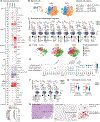
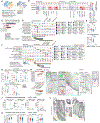

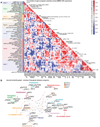
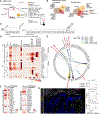
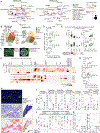
References
-
- André T, Shiu K-K, Kim TW, Jensen BV, Jensen LH, Punt C, Smith D, Garcia-Carbonero R, Benavides M, Gibbs P, et al. (2020). Pembrolizumab in Microsatellite-Instability-High Advanced Colorectal Cancer. N. Engl. J. Med 383, 2207–2218. - PubMed
-
- Bielecki P, Riesenfeld SJ, Kowalczyk MS, Amezcua Vesely MC, Kroehling L, Yaghoubi P, Dionne D, Jarret A, Steach HR, McGee HM, et al. (2018). Skin inflammation driven by differentiation of quiescent tissue-resident ILCs into a spectrum of pathogenic effectors.
Publication types
MeSH terms
Substances
Grants and funding
- R35 CA197735/CA/NCI NIH HHS/United States
- R00 CA259511/CA/NCI NIH HHS/United States
- K08 CA222663/CA/NCI NIH HHS/United States
- K08 CA218420/CA/NCI NIH HHS/United States
- R56 AI137244/AI/NIAID NIH HHS/United States
- R01 CA205406/CA/NCI NIH HHS/United States
- U19 AI133524/AI/NIAID NIH HHS/United States
- U2C CA233195/CA/NCI NIH HHS/United States
- R01 CA208756/CA/NCI NIH HHS/United States
- P50 CA127003/CA/NCI NIH HHS/United States
- T32 CA207021/CA/NCI NIH HHS/United States
- K99 CA259511/CA/NCI NIH HHS/United States
- U54 CA225088/CA/NCI NIH HHS/United States
- U01 CA224146/CA/NCI NIH HHS/United States
- T32 HG002295/HG/NHGRI NIH HHS/United States
- HHSN261201500003C/CA/NCI NIH HHS/United States
- R33 CA160344/CA/NCI NIH HHS/United States
- HHSN261201500003I/CA/NCI NIH HHS/United States
- U54 CA224068/CA/NCI NIH HHS/United States
LinkOut - more resources
Full Text Sources
Other Literature Sources
Medical
Molecular Biology Databases

